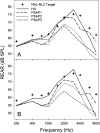A Comparison of Personal Sound Amplification Products and Hearing Aids in Ecologically Relevant Test Environments
- PMID: 30458521
- PMCID: PMC9653212
- DOI: 10.1044/2018_AJA-18-0027
A Comparison of Personal Sound Amplification Products and Hearing Aids in Ecologically Relevant Test Environments
Abstract
Purpose: The aim of this study was to compare the benefit of self-adjusted personal sound amplification products (PSAPs) to audiologist-fitted hearing aids based on speech recognition, listening effort, and sound quality in ecologically relevant test conditions to estimate real-world effectiveness.
Method: Twenty-five older adults with bilateral mild-to-moderate hearing loss completed the single-blinded, crossover study. Participants underwent aided testing using 3 PSAPs and a traditional hearing aid, as well as unaided testing. PSAPs were adjusted based on participant preference, whereas the hearing aid was configured using best-practice verification protocols. Audibility provided by the devices was quantified using the Speech Intelligibility Index (American National Standards Institute, 2012). Outcome measures assessing speech recognition, listening effort, and sound quality were administered in ecologically relevant laboratory conditions designed to represent real-world speech listening situations.
Results: All devices significantly improved Speech Intelligibility Index compared to unaided listening, with the hearing aid providing more audibility than all PSAPs. Results further revealed that, in general, the hearing aid improved speech recognition performance and reduced listening effort significantly more than all PSAPs. Few differences in sound quality were observed between devices. All PSAPs improved speech recognition and listening effort compared to unaided testing.
Conclusions: Hearing aids fitted using best-practice verification protocols were capable of providing more aided audibility, better speech recognition performance, and lower listening effort compared to the PSAPs tested in the current study. Differences in sound quality between the devices were minimal. However, because all PSAPs tested in the study significantly improved participants' speech recognition performance and reduced listening effort compared to unaided listening, PSAPs could serve as a budget-friendly option for those who cannot afford traditional amplification.
Figures









References
-
- Abrams, H. B. , & Kihm, J. (2015). An introduction to MarkeTrak IX: A new baseline for the hearing aid market. Hearing Review, 22(6), 16–21.
-
- Acosta, G. , Hines, A. , & Johnson, J. (2018). Does cognition affect potential benefits of audiologic intervention with OTCs? Paper presented at the American Auditory Society Annual Meeting, Scottsdale, Arizona. Retrieved from http://www.harlmemphis.org/files/1115/2001/8824/OTC_AAS_Poster_Final2.pdf
-
- American National Standards Institute. (2010). Method of measurement of performance characteristics of hearing aids under simulated in-situ working conditions (ANSI S3.35-2010) . New York, NY: Author.
-
- American National Standards Institute. (2012). Methods for calculation of the Speech Intelligibility Index (ANSI S3.5-1997) (R2012) . New York, NY: Author.
-
- Bentler, R. , Palmer, C. , & Mueller, G. H. (2006). Evaluation of a second-order directional microphone hearing aid: I. Speech perception outcomes. Journal of the American Academy of Audiology, 17(3), 179–189. - PubMed
Publication types
MeSH terms
Grants and funding
LinkOut - more resources
Full Text Sources
Medical

